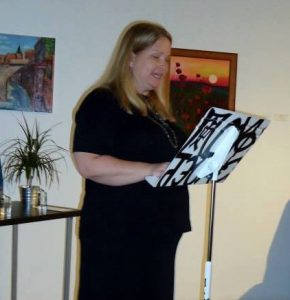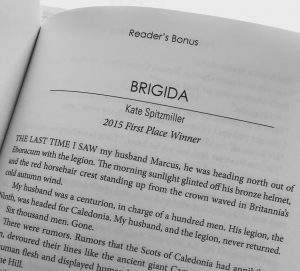Today’s blog post deviates from our usual author spotlights, book reviews, and genre examinations. Instead, we’re bringing you an excerpt from writer Kate Spitzmiller’s short story “U-156”, followed by some questions answered by the author. Note, this article is longer than our typical posts, but you’ll want to stick around for all of it—truly engaging and intriguing through the end. Plus, in the closing paragraph, you’ll find a link for where to read “U-156” in its entirety.
engaging and intriguing through the end. Plus, in the closing paragraph, you’ll find a link for where to read “U-156” in its entirety.
We discovered Spitzmiller when she won our Spider’s Web Flash Fiction contest with her story “Brigida” and received an honorable mention for “Pleiku, 1969”—both are published in the reader’s bonus section of Approaching Footsteps available in our online bookstore. Also of note, “U-156” won an honorable mention for Glimmer Train Press’ New Writers Contest last year.
Without further dilly-dallying, an excerpt from “U-156” by Kate Spitzmiller.
~~~~~
On the ocean, you cannot see the thing that wants to kill you.
In the Atlantic, at least, the waves are too high, too grey, too white-capped. And the thing that hunts you is far beneath those waves, waiting, lurking, and – as I found out – painted grey like the waters of the sea itself. I am told now there were hundreds of them stalking the Atlantic during the war years, like sleek wolves hunting the lumbering, fat prey that were the troop transports and merchant ships plying the waters between America and England. But the only wolf that mattered to me was the one that tried to kill me off the coast of Africa in September of 1942.
U-156.
My mother had died three years previously, and my father – never the best at solo parenting — had finally managed to get rid of us. He was forty-one, retired from twenty years of service with the British Army in South Africa, and too old to fight – or so they said. He had waited two years to be recommissioned by the Army and when word came that he was approved for duty in North Africa, he promptly cabled his sister in Canada and made plans to send my brother Arthur and I off to what we imagined to be a frozen wasteland. We had both been born and raised in Cape Town, and what we knew of Canada came from pictures in our geography textbooks of igloos and icebergs and folks muffled up tight in fur hoods. No more sea lilies and wild lavender for us, we thought. No more beach picnics and warm sea breezes and clear blue skies. Moving to Canada was tantamount to moving to the Arctic Circle, as far as we were concerned.
And so, one day in early autumn, my father packed us up into his aging Vauxall Cadet with one suitcase apiece and drove us down to the docks. We said a simple goodbye — a kiss on the cheek for me, and a pat on the shoulder for Arthur.
“Look after your brother, Lily,” my father said. “You’re in charge until you reach Halifax.”
I was sixteen. Arthur was twelve.
And so we boarded the Laconia.
Thud. Bang. Shudder. Then silence.
Voices in the hallway. The sound of feet pounding on wooden floorboards.
I flicked on the small light above my berth and looked over at Arthur. He was sound asleep.
More voices. Amid the babble, I heard the word torpedo.
I jumped out of bed and scrambled to my brother’s side, as the voices in the hallway grew more frantic.
“Arthur!”
He blinked his blue eyes at me. His brown hair stood out in spikes from the crown of his head.
“Get up! Get dressed!”
“Wha-?”
“Just do it!”
I stripped off my flannel nightgown and threw on my trousers, a blouse, and a wool jumper. Then I opened the cabin door to bedlam. Stewards and passengers in their pajamas swarmed the corridor, everyone shouting and hollering. The stewards were all wearing beige canvas life vests over their white uniforms, and I slammed the door, diving under my bunk for the life vest I knew was tucked underneath.
My brother, never one to wake easily, was halfway into a wool jumper. His eyes were half-closed, as if he were in a trance.
“Hurry up, Arthur!”
“What’s going on?”
“I’m not sure,” I said, trying to keep my voice even. “Just get dressed!”
~~~~~
On the ocean, you cannot see the thing that wants to kill you.
Spider Road Press: Opening sentences are quintessential to a great story. How do you fashion brilliant opening lines like this one? Do you write them first or last or somewhere mid-manuscript and what are the crucial components for a stellar first line for you?
KS: I spend forever on my opening lines. Hours, sometimes. I start with them, staring at a blank page, knowing what my beginning is and trying to come up with a short line to open it up. I want the first line to be able to stand on its own, invite the reader in, give just enough information that the reader just has to keep reading. The line needs to be short and punchy, with tension, and the promise of good stuff to come. It takes a lot of time and a lot of imagination. But the key for me is that it has to be short.
I had an English teacher in high school named George Mechem who always stressed the importance of using as few words as possible. He’d give us assignments of four or five words. Each individual word needed to carry as much meaning and weight as possible. I guess I have him to thank for my ability to make nice, short, opening lines. This story, in particular, also lent itself to a tense opening line because everyone is afraid of what lies below the ocean – I just capitalized on that fear.
~~~~~
He was forty-one, retired from twenty years of service with the British Army in South Africa, and too old to fight – or so they said. He had waited two years to be recommissioned by the Army and when word came that he was approved for duty in North Africa, he promptly cabled his sister in Canada and made plans to send my brother Arthur and I off to what we imagined to be a frozen wasteland.
SRP: Readers appreciate when writers do their homework, as you’ve clearly done in this piece. What resources did you use to learn the historical details needed to write about this era and these people? How much time do you spend on research in ratio to the actual writing?
KS: I actually love research. I was a history teacher for years and am a history tutor now, so I love the process of learning new historical information. In fact, I tend to get a little lost in the research and have to rein myself in. For this story, I probably spent about three hours researching the Laconia incident and U-boats in general. The U-boat research was probably the most important, as the main character spends time inside one, so the descriptions of the interior needed to be correct. For comparison, I probably spent a total of eight to nine hours on the total writing and editing of the story.
As for resources, I mostly use the internet, and I like to use primary sources whenever possible. So, there are a few interviews online of survivors of the Laconia and first-hand accounts from Kriegsmarine sailors about life onboard U-boats. These kinds of resources are invaluable when you are writing historical fiction. Of course, interviews and the like only go back so far in history. My usual time periods are ancient eras, and I generally can’t find primary sources for those pieces of writing. For that, I depend on online libraries, museums, and works such as Herodotus’ Histories.
~~~~~
And so, one day in early autumn, my father packed us up into his aging Vauxall Cadet with one suitcase apiece and drove us down to the docks. We said a simple goodbye — a kiss on the cheek for me, and a pat on the shoulder for Arthur.
“Look after your brother, Lily,” my father said. “You’re in charge until you reach Halifax.”
I was sixteen. Arthur was twelve. And so we boarded the Laconia.
SRP: Using trademarked brands, the names of well-known cities, and other relevant period details can enhance a story but they can also be distracting for some readers. How do you know which ones to include and which ones to leave out or use generic terms for?
KS: This is a tricky balancing act, especially in writing historical fiction. You want to avoid the research “info dump.” In the case of the Vauxhall Cadet, being that it was the 1940s, I felt that the family just “getting into the car” would be, honestly, a bit lame. I didn’t want the reader filling in the blanks and picturing a Toyota Corolla. I felt a more specific type of car was needed here – one from the 1940s. And while most of my readers in the United States aren’t going to know British cars from the 1940s, at least it’s a specific car that gives the sentence some legitimacy.
As far as using specific cities is concerned, I have my BA in geography, so I’m very alert to specific locations and how important it is to have a sort of mental map in any story or novel. That may just be for my own edification, as I often get annoyed by stories or novels or movies that leave out the geographic element (I’m the reader who is always flipping to the front of the novel to look at the map – if there is one). In the case of this specific story, geography was very important as the key plot point was the Laconia’s planned journey from Cape Town to Halifax, crossing an Atlantic Ocean swarming with U-boats. So, I tend to use specific geographic locations whenever possible. It’s the geographer in me.
~~~~~
Voices in the hallway. The sound of feet pounding on wooden floorboards.
I flicked on the small light above my berth and looked over at Arthur. He was sound asleep.
More voices. Amid the babble, I heard the word torpedo.
I jumped out of bed and scrambled to my brother’s side, as the voices in the hallway grew more frantic.
SRP: Successfully writing in first person takes, to some degree, the ability to inhabit your main character’s mind. Is this easy for you? Any tricks or advice you can share about writing in first person POV?
KS: I’ve always found it very easy to write in the first person. It’s actually the easiest POV for me to write in because I do, in essence, “become” the character. I can more easily imagine what she is feeling and experiencing. I’ve tried other points of view, but have found them frustrating because I feel separated from the character. The only trick or advice I can give is that you have to be willing to give yourself over completely to the character. Like you said, inhabit their mind, but also their body, their eyes, their senses. This can be particularly challenging in historical fiction, as the writer is committing herself to inhabiting a character who is living in ancient Rome or Troy or a U-boat in 1942.
It takes effort and imagination and research and a lot of empathy. It can be exhausting. You leave the keyboard after a few hours feeling like you’ve run a mental marathon. But the end result, if you really do it the right way, is writing that reads as if the character is authentic and speaking to you from the page.
~~~~~
I stripped off my flannel nightgown and threw on my trousers, a blouse, and a wool jumper. Then I opened the cabin door to bedlam. Stewards and passengers in their pajamas swarmed the corridor, everyone shouting and hollering. The stewards were all wearing beige canvas life vests over their white uniforms, and I slammed the door, diving under my bunk for the life vest I knew was tucked underneath.
My brother, never one to wake easily, was halfway into a wool jumper. His eyes were half-closed, as if he were in a trance.
“Hurry up, Arthur!”
“What’s going on?”
“I’m not sure,” I said, trying to keep my voice even. “Just get dressed!”
SRP: You’ve managed to strike the balance between dialogue, setting, and action in this story, as well as, a healthy dose of tension. Tell us, are you a plotter, a pantster, or somewhere in between? And any last bit of advice for our readers and fellow writers?
KS: I’m definitely, mostly a pantster. Because I write historical fiction, I start with an event or a concept or a “what if?”, then move on to a beginning and then an ending – not written down, just in my head. But the middle – the actual sitting down and writing of the meat of the story – tends to be all pantstering. I have an end point, so I know where I’m going, but the events that occur between beginning and end tend to be of the pantster variety. I write best that way, letting things flow organically. I like to let the characters show me the way. And I find that some of my very best work has come this way.
In my upcoming novel, I knew I needed two of my characters to meet, get to know each other, and become allies, but I had no idea what they were going to talk about. So, I literally put them in a room together and had them start talking. It turned out to be some of the best dialogue of the novel, and led to some additional plot points. I know this method doesn’t work for everyone, but I find that the organic method works best for me. I’ve tried outlining in the past and I just found myself going off script in a million fabulous directions. The time I’d spent outlining had been basically a waste.
My primary advice for fellow writers would be to keep writing. Keep plugging away. You never know when that short story or bit of flash or novel will catch the eye of somebody and get published. This journey has been full of surprises for me. Some of them good, some of them not so good, but it’s always an adventure. So, keep writing – you never know where that next piece might end up.
When I feel discouraged, I think of writer Andy Weir’s The Martian, a novel which found no agent or publishing house. Weir self-published and the novel absolutely exploded. And then, as you probably know, it became a blockbuster Hollywood movie. So, you never know what fate has in store for you. Believe in yourself, believe in your writing, and keep at it. “Remember The Martian,” that’s my mantra.
~~~~~
 What a great mantra – “Remember The Martian.” A huge thanks to Kate Spitzmiller for taking the time to answer our questions and for being willing to share “U-156” with us. To read “U-156” in its entirety, go to https://katespitzmiller.com/short-story-u-156/. For your copy of Approaching Footsteps, including “Brigida” and “Pleiku, 1969”, head over to https://spiderroadpress.com/book-store/. Thank you, as always, to our awesome Spider Road Press readers, followers, and writers. This post was penned by SRP Blog Editor, Jody T. Morse.
What a great mantra – “Remember The Martian.” A huge thanks to Kate Spitzmiller for taking the time to answer our questions and for being willing to share “U-156” with us. To read “U-156” in its entirety, go to https://katespitzmiller.com/short-story-u-156/. For your copy of Approaching Footsteps, including “Brigida” and “Pleiku, 1969”, head over to https://spiderroadpress.com/book-store/. Thank you, as always, to our awesome Spider Road Press readers, followers, and writers. This post was penned by SRP Blog Editor, Jody T. Morse.
